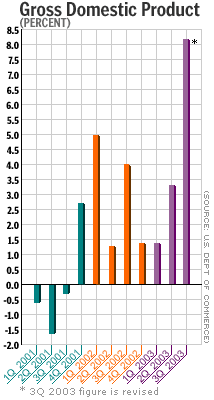NEW YORK (CNN/Money) -
The U.S. economy grew in the third quarter at an even faster pace than originally reported, the government said Tuesday.
Gross domestic product (GDP), the broadest measure of economic activity, grew at an 8.2 percent annual rate, the fastest pace since the first quarter of 1984, the Commerce Department reported. GDP grew at a 3.3 percent pace in the second quarter.

Last month, the government reported that GDP grew at a 7.2 percent clip in the third quarter. Economists, on average, expected that to be revised to 7.6 percent, according to Briefing.com.
The report had little impact on Wall Street, which had widely expected the strong report. Stock prices were little changed at midday, while Treasury bond prices rose.
Separately, consumer confidence rose in November while sales of existing homes fell in October, two reports showed.
One key reason for the large revision in GDP: a re-evaluation of the rate of change in business inventories in the quarter. Originally, the government said businesses cut inventories by $35.8 billion in the quarter, but that figure was trimmed to $14.1 billion in the latest report.
The lower rate of shelf-clearing in the third quarter could mean the economy will get less of a boost from restocking in the fourth quarter than some economists had hoped.
"The bottom line is that Wall Street will have to shave off some of its overly exuberant fourth-quarter real GDP estimates," said Anthony Chan, chief economist at Banc One Investment Advisors.
Third-quarter growth was also boosted by consumer spending, which rose 6.4 percent, the strongest pace since the third quarter of 1997, after growing at a 3.8 percent rate in the second quarter. Consumer spending growth was originally reported as 6.6 percent.
Much of the strength in consumer spending in the third quarter was due to a 26.5 percent rate of growth in the sale of durable goods, items meant to last three years or more, and much of that came in sales of motor vehicles and parts.
It was the strongest performance for durable goods sales since the fourth quarter of 2001, when sales jumped at a 33.6 percent pace. Auto sales have slowed down during the fourth quarter, however.
Consumers got a boost in the late summer and early fall from child tax credit rebate checks and from the tail end of a boom in mortgage refinancing. Cash-out refinancing cut homeowners' monthly payments and put more cash in their pockets, and parents got an extra cash infusion from rebate checks.
Those effects have mostly dissipated in the fourth quarter, however, leading most economists to believe consumer spending will slow.
Unsurprisingly, home sales soared in the third quarter, with residential investment up at a 22.7 percent annual pace, the strongest pace since the first quarter of 1992, compared with 6.6 percent in the second quarter.
Nonresidential fixed investment rose at a 14 percent rate, the fastest pace since the first quarter of 2000, following the second quarter's 7.3 percent pace, a sign of further strength in business spending.
Investment in equipment and software rose 18.4 percent, the fastest pace since the fourth quarter of 1998 and more than double the prior quarter's pace of 8.3 percent.
Many economists have hoped that an upturn in business confidence and spending will fuel a continuing recovery in the labor market, which will make the broader economic recovery more sustainable.
Certainly, businesses got more money to spend in the third quarter. Corporate profits after taxes rose at a 10.6 percent annual rate, the strongest gain since the fourth quarter of 1992, compared with a 5 percent contraction in the second quarter.

|

